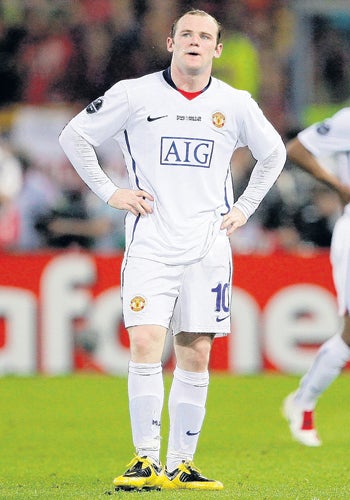Rooney's plight proves what went wrong in Rome

Sir Alex Ferguson used to smile at Brian McClair's willingness to forego his attacking instincts to do a job anywhere on a pitch for Manchester United. "I could say to him 'fill in at right back' and he would do it, no matter where he was asked to go on the field," he recalled recently. "He would do anything, wherever you asked him to play."
The Manchester United manager's recollections of this surfaced in the course of a comparison with Wayne Rooney – a player, he said, who is also "willing to sacrifice the part of the game every forward in the world wants to do, which is just attack." Ferguson was preparing Rooney at the time for another night on the left flank, offering defensive support for Patrice Evra and releasing Cristiano Ronaldo for a free role in the Stadio Olimpico on Wednesday evening.
But at what cost to United? McClair's departure from the centre forward's role was always fleeting but Rooney's sacrifices are more frequent – despite his obvious success partnering Emile Heskey up front in an England shirt – and his anonymity against Barcelona raised once again the question of whether England's finest natural striking force is being wasted during the best of his playing days.
To extrapolate that conclusion is to overlook United's more fundamental flaw in the Eternal City. When Ferguson's side are ticking along and commanding their customary levels of possession, then Rooney is invaluable out there on the left. He certainly does not favour the wide role but it works. Holding midfielders find him easier to pick up when he is playing in the hole behind a striker but post him out wide, cutting inside on his far superior right foot, and he is far more difficult to stop.
The problem in Rome was one of possession, not tactics, as Ronaldo seems to be suggesting. It was the absence of any United midfield player with the ability to grab hold of possession in the central areas which Xavi, Andres Iniesta and Lionel Messi strangled with their processes of triangulation. Liverpool's Javier Mascherano or Chelsea's Michael Essien might have done that midfield job but as Anderson, Ryan Giggs and Michael Carrick laboured the mind drifted back to the days, a decade back, when Roy Keane and a Paul Scholes in his pomp were such a commanding force. Possession would have meant Rooney, with a ball played in at his feet, turning and running at defenders. Consider his semi-final second leg display at Arsenal doing that from the left flank, a more profitable outcome than Rooney being asked to take down occasional long, angular passes, control them on an extraordinarily fast pitch and then set off – as he was forced to do in the decisive first half against Barcelona.
The way Rooney thrives on a good supply line mirrors Thierry Henry on Barcelona's left, attacking defenders from wide to inside – a far more dangerous angle of attack than from the centre out. It was Ferguson who observed only recently that "it's funny to see two centre forwards against their markers and going away from goal. Strikers going inside are far more dangerous."
Reflecting on defeat yesterday, Ryan Giggs declared that United will be looking to make it four consecutive domestic titles and three Champions League finals in a row next year. If United are to make it to the Bernabeu Stadium next May and reclaim their most coveted trophy, they must command the pitch. Then Rooney will be an integral force down the left and not another sacrificial lamb, like Brian McClair.
Subscribe to Independent Premium to bookmark this article
Want to bookmark your favourite articles and stories to read or reference later? Start your Independent Premium subscription today.

Join our commenting forum
Join thought-provoking conversations, follow other Independent readers and see their replies